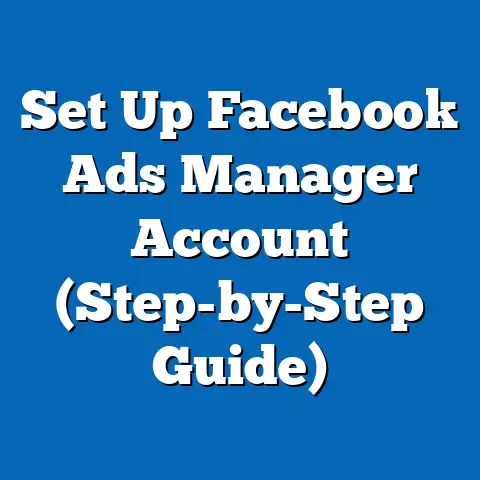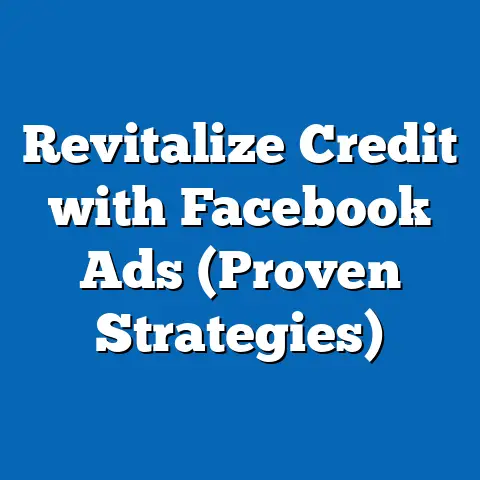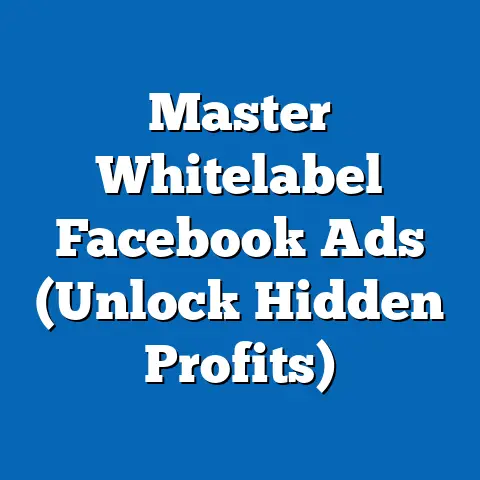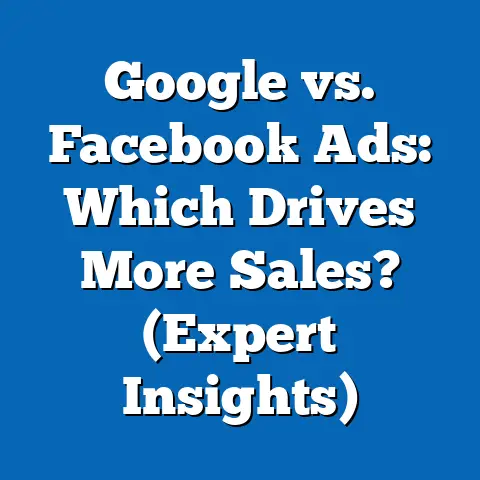Maximize Impact with Effective Facebook Ads (Expert Guide)
Facebook advertising. The words alone can strike fear into the hearts of even seasoned marketers, but here’s the truth: creating effective Facebook ads doesn’t have to be a daunting task. In fact, it’s surprisingly easy and flexible, especially when you understand the core principles and strategies.
I’ve spent years navigating the ever-changing landscape of Facebook ads, from the early days of simple boosted posts to the complex, AI-powered platform we have today. I’ve seen campaigns explode with success and others fizzle out like a wet firework. Through it all, I’ve learned that the key to maximizing impact lies in understanding the platform’s nuances, crafting compelling content, and relentlessly optimizing your approach.
Businesses of all sizes can leverage Facebook’s advertising platform to reach their ideal audience. The user-friendly interface allows for quick adjustments based on real-time analytics. This dynamic nature means your Facebook ads can be adapted to changing trends, audience preferences, and business goals, making it an ideal choice for marketers looking to maximize impact.
In this expert guide, I’ll walk you through everything you need to know to create Facebook ads that deliver results. We’ll cover the fundamentals, dive into advanced strategies, and share actionable tips that you can implement immediately. Let’s get started!
Section 1: Understanding the Facebook Ads Ecosystem
Before diving into the specifics of ad creation, it’s crucial to understand the underlying structure of the Facebook Ads platform. Think of it as a hierarchical system with three key components: Campaigns, Ad Sets, and Ads.
- Campaigns: This is the highest level of organization and defines your overall advertising objective. Are you looking to increase brand awareness, generate leads, drive website traffic, or boost sales? Your campaign objective will influence the type of ads you create and the targeting options you choose. I always tell my clients to start here and think about the overall goals!
- Ad Sets: Within each campaign, you’ll create one or more ad sets. Ad sets control your targeting, budget, schedule, and placement. This is where you define who you want to reach, how much you’re willing to spend, when you want your ads to run, and where you want them to appear (Facebook feed, Instagram feed, Messenger, etc.). Ad sets allow you to test different targeting options and optimize your spending for maximum efficiency.
- Ads: Finally, the ad level is where you create the actual creative content that your audience will see. This includes your ad copy, images, videos, and call-to-action buttons. You can have multiple ads within a single ad set, allowing you to test different variations of your message and visuals.
Understanding this structure is essential for organizing your campaigns and tracking your performance. It allows you to quickly identify which campaigns, ad sets, and ads are performing well and which need improvement.
Choosing the Right Objective
One of the first and most important decisions you’ll make is selecting the right campaign objective. Facebook offers a variety of objectives, each designed to optimize your ads for a specific outcome. Here are some of the most common objectives:
- Awareness: These objectives are focused on increasing brand visibility and reaching as many people as possible. This is a good choice if you’re launching a new product or service and want to get the word out.
- Traffic: This objective aims to drive traffic to your website or app. It’s a good choice if you want to generate leads, promote content, or increase sales.
- Engagement: This objective encourages people to interact with your content, such as liking, commenting, or sharing your posts. It’s a good choice if you want to build a community around your brand.
- Leads: This objective helps you collect contact information from potential customers. It’s a good choice if you want to build your email list or generate sales leads.
- App Promotion: This objective is designed to drive downloads and engagement for your mobile app.
- Sales: This objective focuses on driving online sales. It’s a good choice if you have an e-commerce store or sell products or services online.
Targeting is Key
Facebook’s targeting options are incredibly powerful. You can target people based on demographics (age, gender, location), interests (hobbies, passions, brands they like), behaviors (purchase history, travel habits, online activity), and more.
The key to effective targeting is to understand your ideal customer. Who are they? What are their interests? What are their pain points? Once you have a clear picture of your target audience, you can use Facebook’s targeting options to reach them with relevant and engaging ads.
Takeaway: Understanding the Facebook Ads ecosystem – Campaigns, Ad Sets, and Ads – is fundamental. Choosing the right objective and leveraging Facebook’s powerful targeting options are crucial for reaching the right people with the right message.
Section 2: Crafting Compelling Ad Copy
Let’s face it: people are bombarded with ads every day. To stand out from the crowd, your ad copy needs to be engaging, persuasive, and relevant to your target audience. Think of your ad copy as a mini-sales pitch, designed to grab attention, pique interest, and drive action.
The Power of a Strong Hook
The first few lines of your ad copy are critical. This is your opportunity to grab the reader’s attention and convince them to keep reading. A strong hook can be a question, a surprising statistic, a bold statement, or a relatable anecdote.
For example, instead of saying “We sell high-quality coffee,” you could say “Tired of that afternoon slump? Our ethically sourced coffee will give you the energy you need to power through your day.” See the difference? The second example speaks directly to a pain point and offers a solution.
Speak to Your Audience
Your ad copy should resonate with your target audience. Use language that they understand and that reflects their values and interests. Avoid jargon or overly technical terms that might confuse or alienate them.
Think about the benefits of your product or service, not just the features. How will it make their lives easier, better, or more enjoyable? Focus on the what’s in it for them aspect.
The Importance of a Clear Call-to-Action (CTA)
Your call-to-action (CTA) is the final nudge that encourages people to take the desired action. Use clear and concise CTAs that tell people exactly what you want them to do. Examples include “Shop Now,” “Learn More,” “Sign Up,” “Get Started,” or “Download Now.”
Make your CTA visually prominent by using a button or highlighting it in bold text. Ensure that the link associated with your CTA leads to the appropriate landing page. I once had a client who had a great ad but the CTA led to the wrong page! Simple mistakes like that can cost you big time.
Examples of Effective Ad Copy
Let’s analyze a few examples of effective ad copy:
-
Example 1: Shopify
- Headline: Start Your Free Trial Today!
- Body: Sell anything, anywhere, with Shopify. Build your online store and start selling in minutes. No credit card required.
- CTA: Start Free Trial
- Analysis: This ad copy is clear, concise, and benefit-oriented. It highlights the ease of use of the Shopify platform and offers a free trial, removing the risk for potential customers.
-
Example 2: Grammarly
-
Headline: Great Writing, Simplified
- Body: Grammarly helps you eliminate errors and find the perfect words to express yourself. Be clear, confident, and mistake-free.
- CTA: Get Grammarly – It’s Free
- Analysis: This ad copy focuses on the benefits of using Grammarly, such as improved writing skills and increased confidence. The offer of a free version makes it even more appealing.
Example 1: Shopify
- Headline: Start Your Free Trial Today!
- Body: Sell anything, anywhere, with Shopify. Build your online store and start selling in minutes. No credit card required.
- CTA: Start Free Trial
- Analysis: This ad copy is clear, concise, and benefit-oriented. It highlights the ease of use of the Shopify platform and offers a free trial, removing the risk for potential customers.
-
Example 2: Grammarly
-
Headline: Great Writing, Simplified
- Body: Grammarly helps you eliminate errors and find the perfect words to express yourself. Be clear, confident, and mistake-free.
- CTA: Get Grammarly – It’s Free
- Analysis: This ad copy focuses on the benefits of using Grammarly, such as improved writing skills and increased confidence. The offer of a free version makes it even more appealing.
Example 2: Grammarly
Headline: Great Writing, Simplified
Key Takeaways:
- Start with a strong hook to grab attention.
- Speak directly to your target audience and address their pain points.
- Use clear and concise calls-to-action.
- Focus on the benefits of your product or service.
Next Steps:
- Brainstorm different hooks for your ads.
- Write ad copy that speaks directly to your target audience.
- Experiment with different CTAs to see which ones perform best.
Section 3: Designing Eye-Catching Visuals
In the fast-paced world of social media, visuals are king. People scroll through their feeds quickly, and your ad has only a few seconds to capture their attention. A compelling visual can stop them in their tracks and entice them to learn more.
Why Visuals Matter
Visuals are processed much faster than text. Studies have shown that people remember 80% of what they see but only 20% of what they read. This means that your ad image or video has a huge impact on whether or not people will engage with your ad.
Visuals also help to convey your message more effectively. A well-designed image or video can communicate your brand’s personality, showcase your product’s features, and evoke emotions that resonate with your target audience.
Best Practices for Ad Images and Videos
- Use High-Quality Images: Avoid blurry or pixelated images. Use high-resolution images that are clear and visually appealing.
- Optimize for Mobile: Most Facebook users access the platform on their mobile devices. Make sure your images and videos are optimized for mobile viewing.
- Use Consistent Branding: Use your brand’s colors, fonts, and logo in your visuals to create a consistent brand identity.
- Keep it Simple: Avoid cluttered or overly busy visuals. Focus on a single, clear message.
- Test Different Visuals: A/B test different images and videos to see which ones perform best.
Image and Video Dimensions
Facebook recommends the following dimensions for ad images and videos:
- Single Image Ads: 1200 x 628 pixels
- Carousel Ads: 1080 x 1080 pixels
- Video Ads: 1080 x 1080 pixels (square) or 1080 x 1920 pixels (vertical)
Examples of Successful Ad Designs
-
Example 1: Nike
- Visual: A high-quality image of an athlete wearing Nike shoes, in motion.
- Analysis: Nike’s ads often feature aspirational imagery that inspires people to be active and achieve their goals. The visuals are always high-quality and feature their products prominently.
-
Example 2: Airbnb
-
Visual: A video showcasing a beautiful vacation rental property.
- Analysis: Airbnb’s ads often use video to showcase their unique properties and destinations. The videos are visually stunning and create a sense of wanderlust.
Example 1: Nike
- Visual: A high-quality image of an athlete wearing Nike shoes, in motion.
- Analysis: Nike’s ads often feature aspirational imagery that inspires people to be active and achieve their goals. The visuals are always high-quality and feature their products prominently.
-
Example 2: Airbnb
-
Visual: A video showcasing a beautiful vacation rental property.
- Analysis: Airbnb’s ads often use video to showcase their unique properties and destinations. The videos are visually stunning and create a sense of wanderlust.
Example 2: Airbnb
Visual: A video showcasing a beautiful vacation rental property.
A/B Testing Your Visuals
A/B testing is the process of testing different variations of your ads to see which ones perform best. This is especially important for visuals, as different images and videos can have a significant impact on your ad performance.
To A/B test your visuals, create two or more versions of your ad with different images or videos. Run the ads simultaneously and track their performance. The ad with the best results is the winner.
Key Takeaways:
- Visuals are crucial for capturing attention and conveying your message.
- Use high-quality images and videos that are optimized for mobile viewing.
- Maintain consistent branding in your visuals.
- A/B test different visuals to see which ones perform best.
Next Steps:
- Create a library of high-quality images and videos for your ads.
- Experiment with different visual styles and formats.
- A/B test your visuals to optimize for performance.
Section 4: Targeting Your Audience
Facebook’s targeting capabilities are what truly set it apart from other advertising platforms. The ability to precisely target your ideal customer is a game-changer, allowing you to reach the people who are most likely to be interested in your products or services.
Custom Audiences
Custom Audiences allow you to target people who have already interacted with your business. This can include people who have visited your website, purchased your products, or engaged with your Facebook page.
You can create Custom Audiences by uploading a customer list, using your website traffic data (via the Facebook Pixel), or leveraging app activity data.
Lookalike Audiences
Lookalike Audiences are a powerful way to expand your reach and find new customers who are similar to your existing customers. Facebook analyzes your Custom Audiences and identifies common characteristics, such as demographics, interests, and behaviors. It then creates a new audience of people who share those characteristics.
Detailed Targeting
Detailed Targeting allows you to target people based on a wide range of demographics, interests, and behaviors. You can target people based on their age, gender, location, education, job title, interests, hobbies, purchase history, and more.
Analyzing Audience Insights
Facebook Audience Insights is a tool that provides valuable data about your target audience. You can use it to learn more about their demographics, interests, behaviors, and purchase habits. This information can help you refine your targeting strategies and create more effective ads.
Refining Your Targeting Strategies
The key to effective targeting is to continuously analyze your results and refine your strategies. Track the performance of your ads and identify which targeting options are working best. Experiment with different targeting combinations to see which ones deliver the best results.
Example:
Let’s say you’re selling organic dog food. You could start by targeting people who are interested in dogs, pet care, and organic food. You could then refine your targeting by adding demographics such as age (25-54), location (urban areas), and income (middle to upper class). You could also create a Custom Audience of people who have visited your website or purchased your dog food in the past, and then create a Lookalike Audience based on that Custom Audience.
Key Takeaways:
- Facebook’s targeting capabilities are incredibly powerful.
- Use Custom Audiences to target people who have already interacted with your business.
- Use Lookalike Audiences to find new customers who are similar to your existing customers.
- Use Detailed Targeting to target people based on demographics, interests, and behaviors.
- Analyze Audience Insights to learn more about your target audience.
- Continuously refine your targeting strategies based on your results.
Next Steps:
- Create Custom Audiences based on your customer data.
- Create Lookalike Audiences based on your Custom Audiences.
- Experiment with different Detailed Targeting options.
- Analyze Audience Insights to refine your targeting strategies.
Section 5: Budgeting and Bidding Strategies
Setting a realistic budget and choosing the right bidding strategy are crucial for maximizing your ROI on Facebook ads. You need to find the sweet spot between spending enough to reach your target audience and avoiding overspending.
Daily vs. Lifetime Budgets
Facebook offers two main budgeting options: daily budgets and lifetime budgets.
- Daily Budget: This is the average amount you’re willing to spend each day on your ads. Facebook will try to spend this amount each day, but it may spend slightly more or less depending on the performance of your ads.
- Lifetime Budget: This is the total amount you’re willing to spend on your ads over the entire duration of your campaign. Facebook will try to spread your budget evenly over the campaign period, but it may spend more or less on certain days depending on the performance of your ads.
Bidding Strategies
Facebook offers a variety of bidding strategies, each designed to optimize your ads for a specific outcome. Here are some of the most common bidding strategies:
- Lowest Cost: This strategy aims to get you the most results for your budget. Facebook will automatically bid on your behalf to get you the lowest possible cost per result.
- Cost Per Result Goal: This strategy allows you to set a target cost per result. Facebook will try to get you results at or below your target cost.
- Value Optimization: This strategy is designed to get you the highest possible return on ad spend (ROAS). Facebook will target people who are most likely to make a purchase and spend more money.
- Manual Bidding: This strategy gives you full control over your bids. You can set your own bids for each auction.
Setting Realistic Budgets
Setting a realistic budget depends on a number of factors, including your business goals, target audience, and industry. Here are some tips for setting a realistic budget:
- Start Small: If you’re new to Facebook ads, start with a small budget and gradually increase it as you see results.
- Consider Your Target Audience: The larger and more competitive your target audience, the more you’ll need to spend to reach them.
- Analyze Your Industry: Research the average cost per click (CPC) and cost per acquisition (CPA) in your industry. This will give you a benchmark for setting your budget.
- Track Your ROI: Continuously track your return on ad spend (ROAS) and adjust your budget accordingly.
Key Takeaways:
- Choose the budgeting option that best suits your needs (daily vs. lifetime).
- Select the bidding strategy that aligns with your business goals.
- Set a realistic budget based on your target audience and industry benchmarks.
- Continuously track your ROI and adjust your budget accordingly.
Next Steps:
- Research the average CPC and CPA in your industry.
- Set a small budget for your first Facebook ad campaign.
- Track your ROI and adjust your budget accordingly.
Section 6: Analyzing Performance and Making Adjustments
The journey doesn’t end once your ads are live. In fact, that’s where the real work begins. Analyzing the performance of your ads and making data-driven adjustments is crucial for maximizing your ROI and achieving your advertising goals.
Key Metrics to Track
Here are some of the most important metrics to track in Facebook Ads Manager:
- Impressions: The number of times your ad was shown to people.
- Reach: The number of unique people who saw your ad.
- Click-Through Rate (CTR): The percentage of people who clicked on your ad after seeing it.
- Cost Per Click (CPC): The average cost you paid for each click on your ad.
- Conversion Rate: The percentage of people who completed a desired action (e.g., making a purchase, signing up for a newsletter) after clicking on your ad.
- Cost Per Acquisition (CPA): The average cost you paid for each conversion.
- Return on Ad Spend (ROAS): The amount of revenue you generated for every dollar you spent on advertising.
Accessing Facebook Ads Manager
Facebook Ads Manager is your central hub for managing your Facebook ads. You can access it by going to facebook.com/adsmanager.
In Ads Manager, you can view detailed reports on the performance of your campaigns, ad sets, and ads. You can also customize your reports to track the metrics that are most important to you.
Making Data-Driven Decisions
The data you collect in Ads Manager can help you make informed decisions about your advertising strategies. For example, if you notice that your CTR is low, you may need to revise your ad copy or visuals. If you notice that your CPA is high, you may need to adjust your targeting options or bidding strategy.
Example:
Let’s say you’re running a Facebook ad campaign to promote a new product. You notice that your CTR is low, but your conversion rate is high. This suggests that your ad copy or visuals are not compelling enough to attract clicks, but that people who do click on your ad are likely to make a purchase. In this case, you should focus on improving your ad copy or visuals to increase your CTR.
Key Takeaways:
- Track key metrics such as impressions, reach, CTR, CPC, conversion rate, CPA, and ROAS.
- Use Facebook Ads Manager to access detailed reports on your ad performance.
- Make data-driven decisions to refine your ad strategies and improve your ROI.
Next Steps:
- Familiarize yourself with Facebook Ads Manager.
- Set up custom reports to track the metrics that are most important to you.
- Analyze your ad performance regularly and make data-driven adjustments.
Conclusion
Facebook advertising is a powerful tool that can help you reach your target audience, generate leads, and drive sales. By understanding the platform’s nuances, crafting compelling content, and relentlessly optimizing your approach, you can maximize your impact and achieve your marketing goals.
The beauty of Facebook ads lies in their flexibility. You can easily make changes and adjustments to your campaigns based on the insights you gain from performance analysis. This allows you to continuously improve your results and get the most out of your advertising spend.
Don’t be afraid to experiment, test different strategies, and learn from your mistakes. The more you practice, the better you’ll become at creating effective Facebook ads. With the right strategies in place, you can effectively harness the potential of Facebook ads to achieve your marketing objectives and drive growth.
So, go out there, create some amazing ads, and start seeing the results you deserve! I know you can do it. And remember, I’m always here to help if you need it. Happy advertising!





